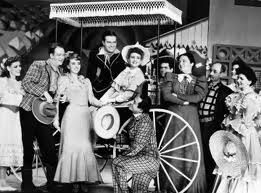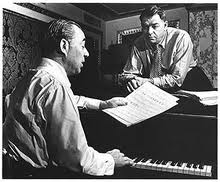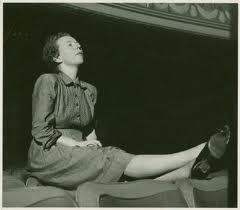Although we’ve already written about Oklahoma! in an introductory blog to this series and also in a separate blog on how people doubted its viability, it would be negligent to eliminate an essay focusing on it as a book musical. That’s because it was Oklahoma! that started the trend towards book musicals. Ironically, it was the music and the dance numbers in Oklahoma! that were partially responsible for developing an interest amongst theatre artists in creating musicals around a solid story, realistic characters and well written dialogue.
Oklahoma! Book
Oscar Hammerstein developed a book for Oklahoma! that was exceptionally solid in every sense of the word. What was and still is amazing was the manner in which he handled the plot and all of the subplots. Although some would say Oklahoma! is relatively simplistic in the manner in which the book is employed, I would have to disagree. In his ability to juggle various subplots, Hammerstein reveals a dexterity that’s akin to Shakespeare.
John Raitt sings Oklahoma! in 1955 with Richard Rodgers conducting.
The major plot, Curly and Laurie, is introduced at the top of the show and the major conflict, which will involve Judd, is alluded to at the same time. In the next scene, we meet Will and then the subplot involving Will and Ado Annie is set up. As that begins to run, we discover Ali Hakim, the travelling peddler, who will have a separate subplot involving Ado Annie and will become a part of the Will and Ado Annie subplot.
Additionally, the conflict between Laurey and Curly sets up another subplot between Judd and Laurie, which then, like the subplot involving Will, Ado Annie and Ali Hakim, creates a triangular subplot with Curly, Laurey and Judd.
If it sounds confusing, it could be. But in Oklahoma! it is amazingly easy and interesting to follow. It’s so easy to follow that it makes the book appear to be simplistic when it is anything but. Why is this the case? There are two basic reasons and their names are Hammerstein and Rodgers (in that order).
Hammerstein gave Rodgers a story and accompanying lyrics that were solidly structured. The progression of each plot, including those involving three characters, is clear and clean and the manner in which he both alternates and connects these plots is exacting. This gave Rodgers an amazing advantage when it came to composing the music.
Rodgers’ Magic
List off about 85% of the songs from Oklahoma!, “Oh, What a Beautiful Mornin’,” “The Surrey with the Fringe on Top,” “Kansas City,” “I Cain’t Say No,” “Many a New Day,” “People Will Say we’re in Love,” “Out of My Dreams,” “Poor Jud is Daid,” “The Farmer and the Cowman,” “All Er Nuthin’,” and “Oklahoma!,” and it’s impossible to name one that doesn’t stick in your head and that doesn’t fit perfectly with the plot, characters and mood.
Hugh Jackman sings Oklahoma! in the 1998 revival.
Rodgers was able to effortlessly blend music with each aspect of the book. This was not the case with Show Boat, where the transitions between Hammerstein/ and Kern’s material are rougher. This may be partly due to the fact that the book is less polished when it comes to the alternating subplots or the fact that Kern interpolated various numbers into the show.
The Weight of Choreography
Oklahoma! is said to be the first musical that integrates all three major performance elements- book, music and lyrics and choreography. That is absolutely true. Agnes de Mille, who was choreographing her first Broadway show, was able to translate text and subtext as well as music and lyrics into movement and dance. She certainly understood character, situation and motivation. Kern and Hammerstein gave her structurally sound music, lyrics and book, which were a great aid to her. At the same time, she reinforced those three elements through her choreography, making for a breakthrough in musical theatre.
Everything’s Up to Date with Oklahoma!
When Oklahoma! opened on Broadway in 1943 everything was truly up to date in the musical. Because the four major performance elements were so intimately connected and for the period seamlessly orchestrated and this integration flowed from the strong book elements, there would be a 25-year period where the book musical was king. Oklahoma! set the standard by which every book musical would be judged.



